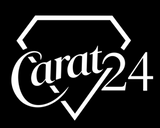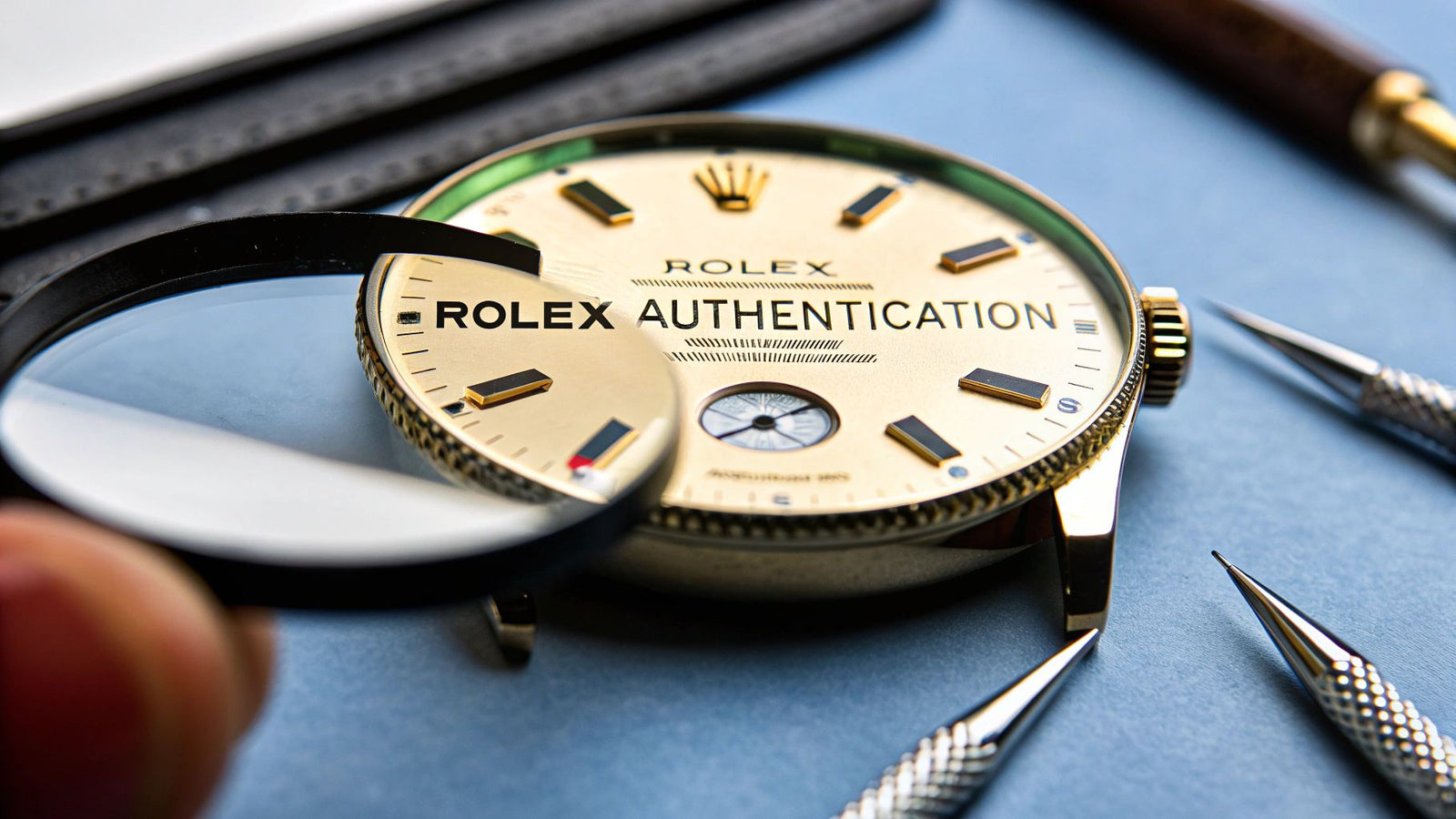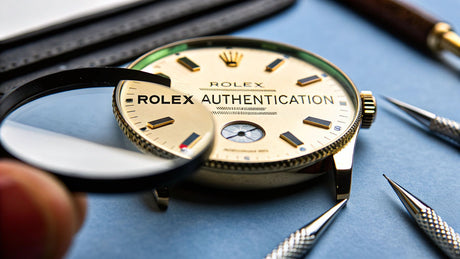Authenticating a Rolex isn't just one single check; it's a careful process of looking at the whole picture. It starts with a meticulous physical inspection, paying close attention to things like the smooth sweep of the second hand, the signature 2.5x date magnification, and the undeniable heft of genuine materials.
But a true verification goes deeper. It combines that critical first look with a detailed examination of serial numbers, movement quality, and official papers to confidently tell a masterpiece apart from a convincing replica.
Your First Look The Telltale Signs of a Genuine Rolex
The moment you first handle a potential Rolex is crucial. Before you even think about serial numbers or what’s ticking inside, a simple physical inspection can wave some serious red flags.
A genuine Rolex has a distinct feel—a noticeable heft and balance that counterfeiters find incredibly difficult to replicate. That’s because Rolex uses its own high-grade 904L stainless steel, which is heavier and more resistant to corrosion than the standard 316L steel you’ll find in most fakes. It just feels substantial.
Beyond the weight, the overall fit and finish tell a story. Run your fingers along the bracelet and case. On a real Rolex, the polishing and brushing are flawless. You'll find razor-sharp edges where they're meant to be and smooth, seamless transitions everywhere else.
Counterfeits often betray themselves with rough spots, uneven finishing, or bracelet links that don't move fluidly. Every last detail, from the perfectly centered crown logo on the clasp to the crisp, clean text on the dial, should be absolutely impeccable.
The Cyclops Lens and Crystal
One of the most iconic—and most poorly copied—features is the Cyclops lens over the date window. An authentic Rolex lens provides a precise 2.5x magnification, making the date jump out and fill the entire window.
Fakes almost always get this wrong. You’ll often see a much lower magnification (around 1.5x) or a date that looks distorted and blurry. The lens itself should also be perfectly centered right over the date.
And let's not forget the glass itself. Rolex has used virtually scratchproof sapphire crystal since the late 1970s. This stuff is incredibly durable and clear. A neat little trick is to see how water behaves on the surface; on a true sapphire crystal, water will form tight, cohesive beads rather than spreading out.
The Sweep of the Second Hand
This is a big one. A hallmark of a genuine Rolex is the smooth, sweeping motion of the second hand. Rolex movements operate at a high frequency, typically 8 ticks per second, which creates an almost fluid glide around the dial.
Most counterfeit watches, especially the cheaper ones, use standard quartz movements. These produce that distinct, jerky "tick-tock" motion you see once per second. It's an immediate and obvious giveaway that something isn't right.
A professional's first glance often goes straight to the second hand. A stuttering or ticking motion is one of the quickest ways to dismiss a potential fake without ever even touching the watch.
To help you get a quick visual, here’s a simple breakdown of what to look for during your initial check.
Authentic Rolex vs Counterfeit A Quick Comparison
This table highlights the key physical differences to look for during an initial inspection of a Rolex watch, helping you quickly spot common red flags.
| Characteristic | Authentic Rolex | Common Counterfeit Signs |
|---|---|---|
| Weight & Feel | Substantial, heavy feel due to 904L steel. Balanced. | Lightweight, feels cheap. Often uses 316L steel. |
| Second Hand | Smooth, sweeping motion (8 ticks per second). | Jerky, ticking motion (1 tick per second). |
| Cyclops Lens | Precise 2.5x magnification, date fills the window. | Low magnification (e.g., 1.5x), distorted or blurry date. |
| Finishing | Flawless polishing, sharp lines, smooth bracelet links. | Rough edges, uneven finish, poorly fitting links. |
| Text on Dial | Crisp, perfectly printed, and evenly spaced. | Blurry text, smudges, or uneven lettering. |
| Crystal | Scratch-resistant sapphire. Water beads up on the surface. | Mineral glass or cheap sapphire that scratches easily. |
While this table is a great starting point, remember that the best fakes are getting better every day, making a trained eye more important than ever.
Bringing It All Together
Any professional watch authenticator will tell you that it’s the combination of these physical and mechanical details that provides the most reliable verdict, especially in the pre-owned market. Experts confirm that a deep dive into the quality of the internal movement is paramount, as Rolex's precision engineering and finishing standards are nearly impossible for counterfeiters to mimic perfectly. This expert-level check also includes scrutinizing the quality of serial number engravings, case construction, and the accuracy of the dial printing.
You can learn more about the rigorous authentication methods used by experts to verify luxury timepieces.
Ultimately, while these initial checks are powerful tools, they are just the first step. For absolute certainty—especially when a significant purchase or sale is on the line—nothing replaces professional verification. If you're looking for the highest payout in Boise for your luxury watch or jewelry, a thorough and honest evaluation is key.
Our expert Gold and Jewelry Buying services offer hassle-free offers complete with Xray Scanning and Gold Testing for free, ensuring you get a fair valuation backed by our Price Matching guarantee. You can save the hassle and sell locally for more than online shipments, all with the confidence that comes from a trusted expert assessment.
Decoding Serial Numbers and Engravings
Beyond the initial feel and finish, a Rolex’s true identity is literally etched into its metal. Every genuine watch has a unique serial number and a model reference number—think of them as its birth certificate and blueprint. Knowing where to find these and what to look for is one of the most reliable ways to sniff out a fake.
For decades, Rolex kept these critical numbers tucked away. If you're looking at a vintage model made before 2005, you'll need to remove the bracelet. The serial number is deeply engraved between the lugs at the 6 o'clock position, and the model number is at the 12 o'clock spot. This was an intentional design choice to keep them discreet.
As counterfeiters got better, Rolex had to adapt. On watches made after 2005, you'll find the serial number engraved on the inner bezel, which is the metal ring between the dial and the crystal. The industry term for this is the rehaut. The big advantage? You can see it clearly without taking the watch apart.
The Quality of the Engraving Matters
Just finding the numbers is only half the job. The quality of the engraving is where many fakes fall apart.
A real Rolex has engravings that are incredibly sharp, deep, and precise. They’re cut with diamond-tipped tools or sophisticated lasers, creating clean lines that catch the light with a distinct shimmer.
On the other hand, fakes often have shallow, faint, or sloppy engravings. A lot of counterfeiters use a crude acid-etching process that leaves behind a sandy or dotted texture inside the numbers. If the engravings look blurry, uneven, or just don't have that crisp, three-dimensional depth, you should be extremely suspicious.
A dead giveaway for counterfeiters is often the font and spacing. Rolex uses very specific, hard-to-replicate fonts for its engravings. Pay close attention to the shape of each number—they should be absolutely perfect.
Verifying a Rolex has always come back to these unique identifiers. You can cross-reference these numbers with official databases or service centers to confirm the watch’s legitimacy, when it was made, and its model details. This is non-negotiable in the pre-owned market, especially when the original papers are long gone.
The image below highlights another simple but important physical check: the weight. It speaks volumes about the quality of the materials used.
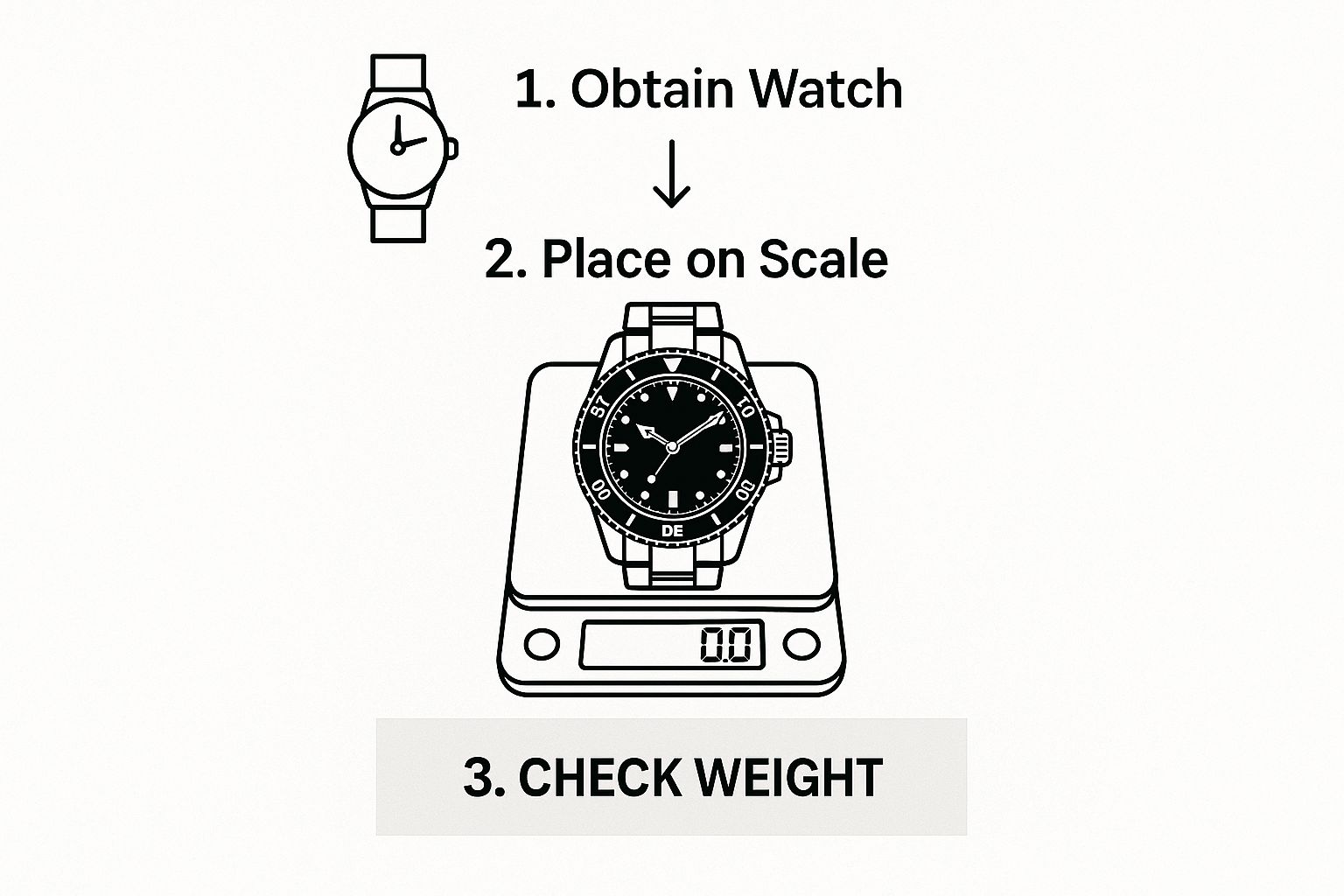
This just goes to show that authenticating a Rolex often starts with tangible details, like its substantial heft—a direct result of the high-quality metals used in its construction.
Putting It All Together for a Confident Sale
At the end of the day, a serial number check is a powerful piece of the authentication puzzle, but it’s most effective when you combine it with other checks. The quality of the metal itself—whether it’s 904L steel or 18k gold—is just as important as the numbers engraved on it. If you're thinking about selling a luxury piece, this level of detail is critical.
For those looking to sell valuables, it's always helpful to understand how different precious metals are valued. For instance, you might find our guide on how much a gold tooth is worth insightful, as it breaks down how value is determined.
When you’re ready for an expert opinion, especially if you want the highest payout in Boise, bringing your watch to a trusted specialist is the final, essential step. At our Gold and Jewelry Buying center, we provide Xray Scanning and Gold Testing for free to verify your watch's materials without any risk of damage. We give hassle-free offers and have a Price Matching guarantee. Why deal with the stress of shipping your valuables when you can save the hassle and sell locally for more?
Examining the Heart of the Watch: The Rolex Movement
If the outside of the watch is the first line of defense against fakes, the movement is the final, undeniable proof. This is the intricate engine—the very soul of a Rolex—and it's where even the most convincing knock-offs completely fall apart.
Popping open a watch caseback is a job best left to a professional with the right tools, but every serious buyer or seller needs to understand what’s supposed to be inside.
A genuine Rolex movement is a masterpiece of micro-engineering. It's not just about telling time; it's a work of art. Every surface is adorned with meticulous patterns, and key components are engraved with the brand's name, caliber number, and other identifiers. Counterfeiters just can't afford to replicate this level of obsessive detail and craftsmanship.
Even the so-called "super clone" movements, which might look similar at a glance, will fail under close inspection. They often use cheaper materials, lack the precise finishing, and will never come close to the legendary durability and accuracy of the real thing. It’s this internal artistry that truly separates a lifelong investment from a worthless imitation.
Signature Details of a Rolex Caliber
When an expert opens a Rolex, they're looking for specific, tell-tale signs of authenticity that are almost impossible for forgers to get right.
One of the most recognizable features in modern Rolex movements is the vibrant color of certain parts. Keep an eye out for the distinct red or purple anodized reversing wheels in the self-winding mechanism. These brightly colored gears are an iconic, immediate sign that you're likely looking at a genuine caliber.
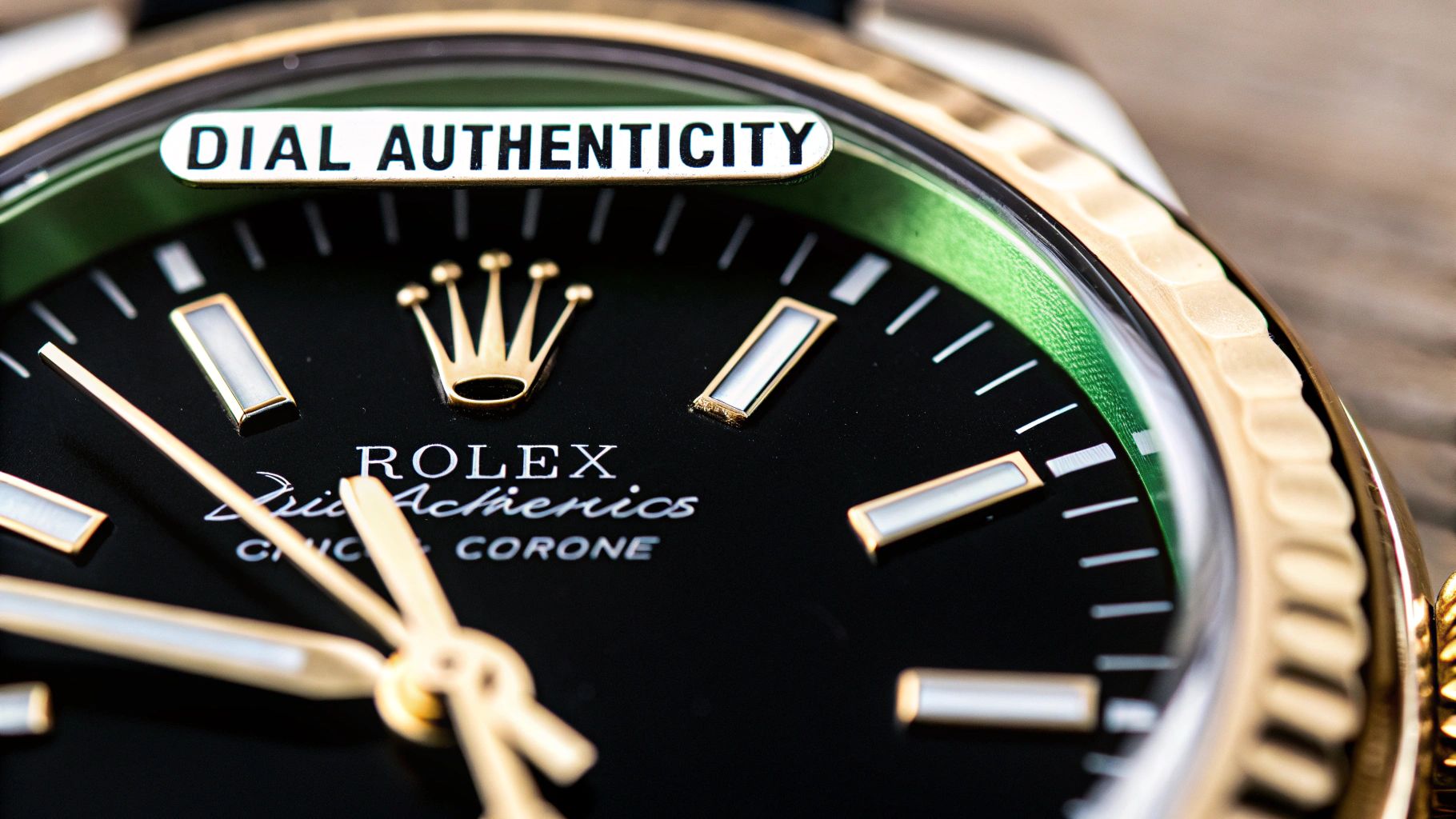
On top of that, the balance bridge and other parts are often finished with unique textures. The engravings—"ROLEX," "GENEVA," "SWISS," and the caliber number—should be perfectly sharp and clean, not shallow or sloppy. Every screw, jewel, and gear is placed with absolute precision.
A professional watchmaker can often spot a fake in seconds just by looking at the movement. The difference in quality, finishing, and even the color of the components is that dramatic. It's the difference between a high-performance engine and a cheap plastic model.
Why Professional Inspection Is a Must
Knowing these details is powerful, but it also highlights why you need a professional to verify them. Without the proper tools and training, you risk scratching the caseback, damaging the delicate movement, or messing up the watch's water resistance. A quick, botched inspection can easily lead to costly repairs.
Here’s what a professional inspection of the movement actually confirms:
- Authentic Components: Verifying that every single part, from the balance wheel to the winding rotor, is a genuine Rolex part.
- Correct Caliber: Ensuring the movement inside matches the specific model and production era of the watch.
- Quality of Finishing: Inspecting the perlage, Geneva stripes, and other decorative finishes that are hallmarks of true Rolex craftsmanship.
- Absence of Tampering: Checking for signs of bad repairs, aftermarket parts, or damage that could tank the watch’s value and performance.
This level of detail is crucial, whether you're buying a pre-owned piece or getting ready to sell. For sellers, this verification is key to getting the best price, just as understanding the value of precious metals is. If you're curious about how value is determined in other areas, exploring the 5 oz of silver value can provide interesting parallels in the world of tangible assets.
For anyone in Idaho, getting a professional opinion is simple and totally risk-free. Our Gold and Jewelry Buying services in Boise provide hassle-free offers for luxury items like Rolex watches. We offer a free assessment using non-invasive Xray Scanning and Gold Testing to confirm materials without ever needing to open the case unnecessarily.
Plus, we offer Price Matching to ensure you get the highest payout in Boise. You can save the hassle and sell locally for more than online shipments, all with the confidence of an expert evaluation.
Verifying Paperwork and Provenance
A Rolex is so much more than a watch—it's an asset, and it comes with a story. The original box and papers, often called a "full set" in the watch world, are a huge part of that story. But just seeing them isn't enough. You have to know how to authenticate the documents themselves, because counterfeiters have gotten scarily good at faking the paperwork, too.
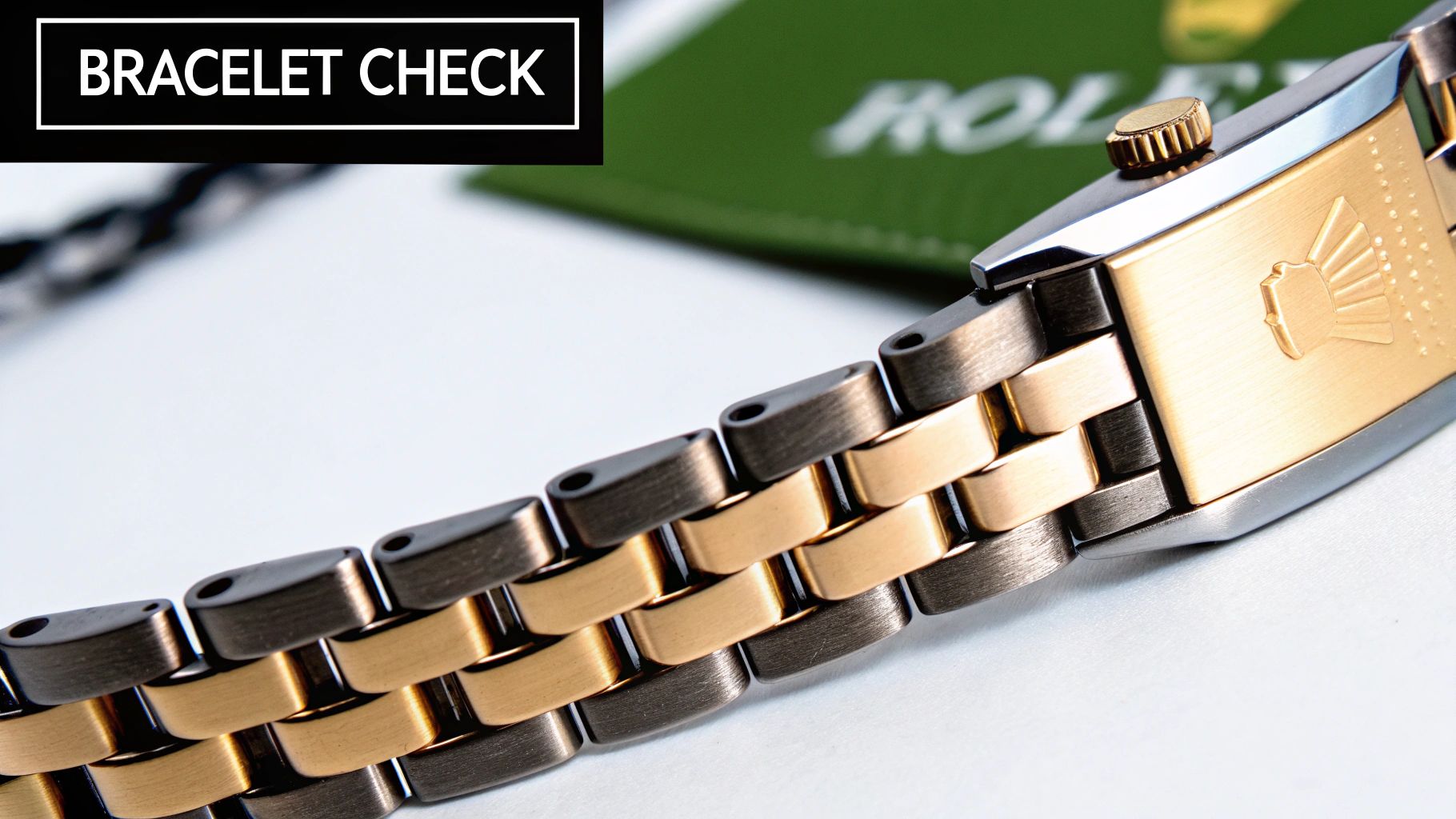
The single most important document you’ll handle is the warranty card. Modern Rolex warranty cards are plastic, feeling much like a high-quality credit card, and they’re packed with specific security features. The text should be perfectly crisp and laser-etched, never fuzzy or blurred. Even older paper certificates have their own tells, but the guiding principle is always the same: the quality must feel absolutely top-notch.
Scrutinizing the Warranty Card
The very first thing you need to do is check the serial number printed on that card. It has to be an exact match to the serial number engraved on the watch itself, whether it's on the inner rehaut ring or tucked between the lugs on an older model. If there's any discrepancy—even one wrong digit—it's an immediate, deal-breaking red flag.
Beyond the serial number, dig into the other details on the card:
- Model Number: Does the reference number on the card match the watch model you're holding? It seems simple, but it's a common oversight.
- Dealer Information: The card should clearly name the official, authorized dealer where the watch was first sold.
- Holograms and Security: Newer cards feature intricate holograms and sometimes a magnetic strip or QR code. These elements are incredibly difficult for fakers to replicate perfectly.
A common trap I see is what we call "mismatched" paperwork. This is when a seller pairs a genuine but totally unrelated set of papers with an authentic watch just to drive up the price. Don't fall for it. Always, always confirm that serial number is a perfect match.
Building the Watch's Story with Provenance
The warranty card is just chapter one. The watch's provenance—its documented history of ownership and service—is what really brings its story to life, boosting its value and cementing its authenticity.
Original sales receipts and official service records are pure gold. These documents create a paper trail that traces the watch’s life from the showroom floor right up to the present day. When you're looking at service papers, look for the letterhead of an authorized Rolex Service Center and make sure the work described makes sense for the watch's current condition. A solid, well-documented history is one of the strongest signs of a legitimate, well-cared-for timepiece.
Ultimately, authenticating the paperwork is a crucial piece of the puzzle. It confirms the watch's identity and history, giving you peace of mind. If you ever feel a flicker of doubt, or if you're looking to sell a luxury timepiece, getting an expert opinion is the smartest move you can make. When you're ready to learn about our process for Gold and Jewelry Buying, you can explore our hassle-free selling options and see why so many people choose to work with a trusted local expert.
For those in Idaho, we offer the highest payout in Boise with a firm Price Matching guarantee. Our services include complimentary Xray Scanning and Gold Testing to verify your items with absolute precision. You can save the hassle and sell locally for more than online shipments, all while receiving a transparent, hassle-free offer.
The physical checks we've gone through are the bedrock of authentication, the tried-and-true methods we've relied on for years. But the ground is shifting under our feet. As counterfeiters get scarily good, Rolex is looking over the horizon, building out forward-thinking ways to protect its legacy and, more importantly, your investment.
The future of proving a Rolex is genuine is undeniably digital. We're moving beyond the magnifying loupe and into the world of secure, transparent technology.
This isn't just some far-off concept; it's happening right now. One of the biggest moves involves Rolex's deep dive into blockchain technology and Non-Fungible Tokens (NFTs). They recently filed a patent outlining a wild new authentication system using an embedded NFT chip right in the watch or its warranty card.
The idea is simple but powerful: the chip would allow for real-time verification of the watch's entire history and ownership just by scanning it with a smartphone. Think of it as a digital certificate of authenticity, locked securely on a blockchain. You can get a better sense of how Rolex is embracing this blockchain innovation on blog.watchanalytics.io.
How Digital Verification Changes Everything
This new approach creates an unforgeable link between a physical watch and its digital soul. Just imagine a world where you can instantly confirm a watch's authenticity, see its complete service history, and verify every owner it's ever had with a single tap. It’s a game-changer.
This system brings a few key advantages to the table:
- Unmatched Security: A record on a blockchain can't be altered or faked. It offers a permanent and trustworthy ledger of the watch's entire life.
- Instant Verification: Buyers and sellers can authenticate a watch on the spot. No more doubt, no more lengthy verification processes.
- Complete Transparency: A watch's provenance is no longer just a stack of papers. It becomes a secure, accessible digital file you can pull up anywhere.
This shift represents a monumental leap in the fight against high-end counterfeits. By tying a watch to a unique digital token, Rolex can create a level of security that is nearly impossible for forgers to breach, protecting the integrity of every timepiece that leaves its workshops.
What This Means for Owners and Collectors
For anyone buying a Rolex in the future, this digital system will provide a level of confidence we've never seen before. The days of worrying about mismatched paperwork or undisclosed service histories will be over. Every single detail, from its original sale to its last service, will be logged forever.
Even if a watch needs a new part, our experts in professional jewelry repair understand how crucial it is to maintain a watch's integrity and value through proper care, something a digital history will perfectly track.
While this technology is still rolling out, it signals a clear direction for the entire luxury watch industry. As these digital systems become the norm, the value of a fully verified, digitally authenticated Rolex is only going to climb.
For those of us in the Gold and Jewelry Buying industry, this evolution is incredibly exciting. It empowers us to offer even more certainty to our clients. Here in Boise, we provide hassle-free offers and ensure the highest payout by using the best verification tools available, including Xray Scanning and Gold Testing for free. We stand by our Price Matching guarantee, allowing you to save the hassle and sell locally for more than online shipments.
Sometimes, you’ve done all you can. You’ve checked the serial numbers, scrutinized the dial, and listened to the movement. But a nagging feeling remains. This is when you know it’s time to call in a professional.
Knowing how to spot the obvious fakes is a great skill, but ensuring a Rolex is 100% authentic, especially when big money is on the line, often requires an expert's touch.
When an Expert Eye Is Non-Negotiable
Certain situations just scream for a professional appraisal. If you're about to pull the trigger on a purchase from a private seller, or you're looking to sell a significant piece yourself, getting an expert opinion is non-negotiable. It’s an essential layer of security that protects both the buyer and the seller, ensuring the whole transaction is fair and transparent.
Vintage Rolexes are a whole different ballgame. These watches can have incredibly nuanced histories, replacement parts that are technically correct but not original to the piece, or subtle variations that only a seasoned pro would catch. Authenticating a vintage piece isn't just about "real vs. fake"—it's about verifying originality, condition, and provenance. All of these factors can drastically swing its value.
Trust your gut. If you have any lingering doubts—a slightly off engraving, a service history that doesn’t quite add up, or just an instinct that something is off—listen to it. That’s your sign to seek a professional opinion.
Get a Definitive Answer in Boise
For those of us here in Idaho, thankfully, this process is straightforward and completely risk-free. When you need a definitive answer on your timepiece, especially for Gold and Jewelry Buying, the smartest move is to turn to a trusted local expert right here in Boise.
We're committed to providing hassle-free offers and guaranteeing you the highest payout in Boise, backed by a solid Price Matching promise.
Transparency is everything to us. That’s why we offer complimentary, non-invasive verification for your luxury items. We use Xray Scanning and Gold Testing for free, which allows us to confirm the exact material composition of your watch without leaving so much as a fingerprint. It’s the kind of concrete data needed for an absolutely accurate appraisal.
Why go through the stress of shipping your valuables off to someone you’ve never met? You can save the hassle and sell locally for more than online shipments. A professional appraisal doesn't just confirm authenticity; it empowers you with the knowledge to get the true value your cherished timepiece deserves.
Answering Your Rolex Authentication Questions
When you’re dealing with something as valuable as a Rolex, questions are going to come up. It's only natural. Getting straight, honest answers is the best way to feel confident, whether you're buying, selling, or just curious about a family heirloom. Let's tackle some of the most common questions we hear.
Can You Authenticate a Rolex by Serial Number Alone?
This is probably the number one question we get. The short answer? No.
A serial number is a fantastic starting point. It helps us pinpoint the watch's production date and cross-reference it with the model's known history. But here's the catch: a skilled counterfeiter can easily engrave a real serial number onto a fake watch. That's why relying on the serial number by itself is a rookie mistake. It has to be part of a much more thorough physical inspection.
Can I Get a Real Authentication Without Opening the Watch?
For the most part, yes, you absolutely can. A trained eye can spot over 99% of fakes just by examining the watch's exterior. We're talking about things that counterfeiters consistently get wrong:
- The Weight: Real Rolexes have a signature heft to them from the quality of the steel and precious metals.
- The Second Hand Sweep: A genuine Rolex movement produces a smooth, gliding sweep, not the jerky tick-tock of a cheaper quartz movement.
- The Cyclops Lens: The date magnification on a real Rolex is precisely 2.5x. Fakes almost never get this right.
- The Dial Details: Look at the text and coronet. Rolex printing is flawless—sharp, crisp, and perfect. Fakes often have fuzzy edges or slightly off spacing.
With that said, the "super fakes" coming out these days are scarily good. For absolute, iron-clad certainty, the only way is to open the caseback and look at the movement. The intricate finishing and engineering of a Rolex caliber is one thing the counterfeit world just can't replicate perfectly.
Do All Real Rolex Watches Have Papers?
It's a common belief that if a Rolex doesn't have its original box and papers, it must be fake. That’s simply not true.
Think about it—for vintage pieces that are decades old, it's incredibly common for the original paperwork to have been lost, misplaced, or thrown away over the years. A "full set" with the box and papers is definitely a bonus and adds significant value, but its absence is not a red flag for authenticity. A genuine Rolex is genuine, with or without its birth certificate.
The key thing to remember is that proper authentication isn't a single checkbox. It’s a holistic process. It's about the sum of all the parts—from the feel of the bracelet to the flawless sweep of the second hand.
For anyone in Idaho wanting to cut through the noise, getting these questions answered is easy. Our Gold and Jewelry Buying services right here in Boise are built on clarity and trust. We offer Xray Scanning and Gold Testing for free to verify the materials with scientific precision. This ensures you get a fair, hassle-free offer you can feel good about.
We’re so confident in our process that we guarantee the highest payout in Boise, and we even offer Price Matching. You can save the hassle and sell locally for more than online shipments, all while getting the expert answers you deserve.
Ready to discover the true value of your luxury items? At Carat 24 - Trusted Gold Experts, we offer transparent, expert evaluations to ensure you get the best possible offer. Visit us in Boise or learn more on our website today.
